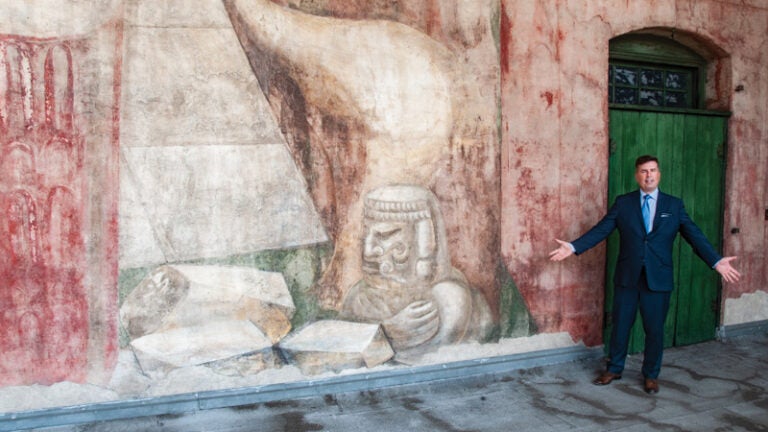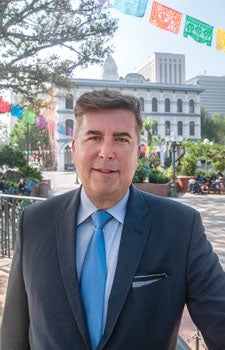
The Compassionate Guardian
Striding through the plaza of El Pueblo de Los Angeles Historical Monument, Robert Vinson cuts a dapper and purposeful figure. Shopkeepers at the colorful Mexican market on nearby Olvera Street and workers at the Chinese American Museum nod and smile as he passes. “Good morning, Commissioner. Good to see you,” one calls out.
Vinson is president of El Pueblo de Los Angeles Board of Commissioners, the city authority that governs the historic site, considered the birthplace of L.A.
In September 1781, following a journey of more than 1,000 miles, part of it across the desert from what is today northern
Mexico, 44 settlers of Native-American, African and European heritage established a farming community not far from El Pueblo’s current location. Today, seven museums, the Olvera Street market and many historic buildings, including the city’s oldest, the Avila Adobe, mark the site.
The monument, which attracts more than 2 million visitors annually, promotes itself as a living museum, the historic and symbolic heart of the city.
El Pueblo, Vinson says, is important on many levels. It is the birthplace of the city — a diverse community from its beginnings. “It’s always important that we honor and remember that,” he said.
“It’s also in the middle of downtown L.A., which is rapidly changing. So, we’re strategically placed to have a unique effect on how this area is developed and what’s important.”
Vision of compassion
Appointed by L.A. Mayor Eric Garcetti, Vinson is determined that El Pueblo lead the way for the kind of compassionate city he hopes L.A. can become.
“My vision for El Pueblo is that the dance between its culture and history and the development of downtown move in sync,” Vinson said.
But being the guardian of the 44-acre El Pueblo is a delicate balancing act. It’s one that Vinson is passionate about.
He must carefully weigh how the neighborhood maintains its history, whether services should be provided for the area’s homeless population and how that balances with the needs of local merchants.
“It’s up to this commission to lead the way, to decide what’s important,” he said.

As president of El Pueblo de Los Angeles Board of Commissioners, Robert Vinson must weigh the diverse needs of all who live and work in the historic district.
Recalling the 18 Chinese massacred during the race riot of 1871 on the site of what is now the Chinese American Museum, and the undocumented Angelenos who, in the 1930s, were lured to what was then the Mexican Consulate in El Pueblo and then deported, Vinson said, “The history of this place has to be presented in a way that’s always a teachable moment, not just celebrated by having some trinket that is reminiscent of a time gone by.”
Now, thanks to Vinson’s stewardship, El Pueblo will host L.A.’s first “A Bridge Home” housing program for the homeless. The initiative, launched by Garcetti, will house 45 homeless people for a three-month period. They will receive treatment for mental health and substance abuse issues, along with services to help them get back on their feet. At the end of the 90-day period, they will be moved into permanent housing and another cohort will take their place.
“Frankly, it’s been a struggle to pull off, largely because of nimbyism,” Vinson admits, “but it’s very important because until people’s basic needs are met, services are just not going to be as effective.”
Helping L.A.’s homeless is an El Pueblo tradition, Vinson notes. Both churches on the plaza have a long history of aiding those on the streets.
It’s also the kind of compassionate action those who know him have come to expect of Vinson. The motto of VRG Vinson Real Estate Group, the real estate brokerage firm he opened more than 20 years ago, is “Building Community.” To that end, clients may opt to have 10 percent of Vinson’s commission go to a charity of their choice.
Vinson has also built affordable single-family housing. Tupper Tobias Village in Panorama City, which provides 28 homes aimed at single parents, is one notable example.
Vinson said that when he acquired the property, he could have built more than 100 apartments.
“Instead, I went door-to-door to all of the neighbors and asked, ‘What do you want here?’ ” he said. Residents’ biggest concern was losing the neighborhood’s single-family home character, so Vinson and architect Michael Mekeel, his business partner, designed a community where parents could see their children playing — and ensured the cost to own a home didn’t exceed what they would pay to rent.
Vinson serves on the advisory board of Los Angeles Alliance for a New Economy (LAANE), a social justice nonprofit that helped pass L.A.’s minimum wage ordinance and reduce truck-related pollution at the Port of Los Angeles by 90 percent. The nonprofit is also bringing recycling services to 500,000 apartment residents.
The project Vinson is proudest of is one he created while serving on the board of Alternative Living for the Aging. He described the concept as a way to promote “independence through interdependence” by building housing for groups of people with different skills, so one person drives, one plays the piano, another cooks.
“It created these beautiful communities, and residents lived longer and were happier and healthier,” he said.
That sense of compassion, which has been a driving force and a guiding principle in his professional life, Vinson credits to his single mother, Darlene Montano, an Emmy-nominated set decorator, painter and sculptor.
A magical childhood
A native Angeleno, Vinson grew up near Encino in the west San Fernando Valley. It was an idyllic childhood, Vinson says. His Mexican mother took him to museums and he spent weekends with his father, Robert Vinson Sr., a studio executive at MGM. “He was the consummate Disneyland dad,” Vinson chuckles fondly.
Vinson was a keen magician as a young child. “I was in the junior Magic Castle,” he said with pride. In addition to making a lot of his own magic tricks, 8-year-old Vinson performed shows for younger kids (“I had capes; I loved capes”), appeared on the children’s television show Romper Room and collected old magic books from the 1920s that he scouted out in L.A.’s secondhand and antiquarian bookshops.
Yoga and Shakespeare were Vinson’s other fascinations growing up, along with photography.
“I had a photo lab given to me by a friend of my father who was a spy in Germany,” Vinson said. “I most enjoy photographing people — it gives me the opportunity to capture a moment of humor.”
Vinson credits his mother with shaping his political views.
“When she went to work in studios, I had a front row seat to the sexism she had to endure,” he said. “I became sensitive to the plight of people through my mom, and that’s really how I developed my sense of compassion.”
He also credits her determination with getting him into USC after she worked on a scene filmed on USC’s Fraternity Row and was impressed by the residents’ studiousness.
Art and happiness
Vinson started out majoring in theatre but transferred to USC Dornsife, where he graduated in 1995 with a bachelor’s degree in humanities.
“I wanted to be practical, and I was interested in urban planning and politics, so I transferred into USC Dornsife and minored in theatre instead. As you travel further from your ego, you don’t need to be on stage as much.”
Vinson put himself through USC in an unusual way — as the owner of The 2nd Coming, a nightclub located in L.A.’s Westlake district.
Wanting to create a venue where he could bring cultures together, he booked mainly world music. Tom Schnabel of KCRW was involved. Tom Tom Club played for three weeks (David Byrne and Debbie Harry performed together at the band’s last show there). Vinson rubbed shoulders with guests like David Bowie, Bruce Springsteen and Barbra Streisand.
Vinson also organized art shows. When the Los Angeles County Museum of Art held a major Latin America retrospective in 1991, Vinson exhibited important Latino artists from L.A. who were not included in the LACMA show.
“Our alternative show was so much more interesting. We had an old ’50s Chevy that was painted by Latino artists. The seats were flaming chiles.
“Art is seminal,” Vinson said, “because it’s what we do everything for — art and happiness.”
He experienced plenty of the latter at USC, where he made friends from Taiwan, Iran, Mexico, South America and France.
“Realizing that there are different approaches to the same everyday problems and issues — there’s no better way to broaden yourself than to see how other people solve the same problems you’re faced with,” he said.
Vinson closed his nightclub shortly before graduating. He worked briefly for a global bank before his love of people drew him into real estate and politics.
Vinson met his long-term mentor, Josh Baran, owner of an L.A.-based public relations firm, when the two organized an event at USC.
“Baran taught me the full importance of compassion and getting past my own ego, which is my real life’s work,” Vinson said. “I was really fortunate to have a mentor like that.”
Through Baran, Vinson made contacts in Bill Clinton’s campaign and started organizing events and coordinating press for President Clinton, Secretary of State Hillary Clinton, former Vice President Al Gore and Secretary of State John Kerry.
“It was a great experience, with the constant sense of witnessing history firsthand,” Vinson said. “The respect I have for each of those candidates is only compounded because I saw their human side.”
Vinson remains deeply involved in politics and, at the time of writing, was working toward ensuring California Democrats gained U.S. House seats in the November midterm election.
The meaning of life
Baran also introduced Vinson to meditation and to the Dalai Lama, whom Vinson worked with for years, managing press and event production for the spiritual leader’s American tours.
Vinson family connections with El Pueblo go back a long way. His maternal grandfather, Robert Montano, who described himself as “the most skilled cabinetmaker in L.A. still with all 10 fingers,” was a regular customer at the neighborhood’s saloon and then at it’s speakeasy during Prohibition. Vinson has a treasured photograph of his mother, aged 9, next to the cross marking the entrance to El Pueblo and vivid memories of his own cherished childhood visits.
Now, as he walks through El Pueblo, Vinson carries with him the Dalai Lama’s words.
“He was asked, ‘What is the meaning of life?’ Vinson recounted. “And he said without hesitation, ‘To be happy.’ ”
Vinson took the answer to heart.
“It’s the best piece of advice I’ve ever heard.”
Read more stories from USC Dornsife Magazine’s Fall 2018/Winter 2019 issue >>